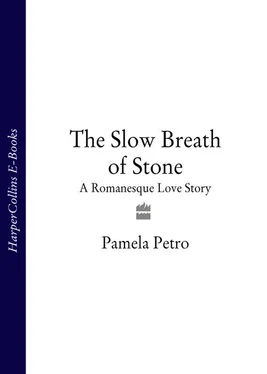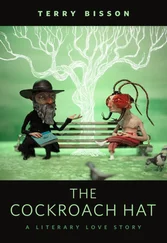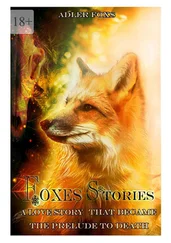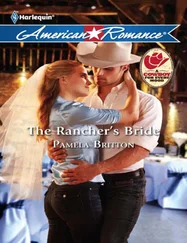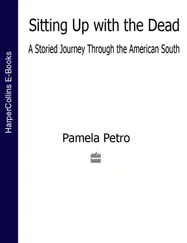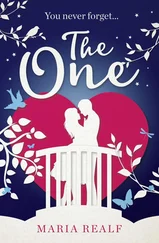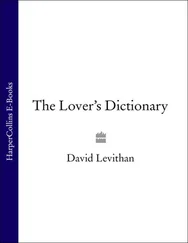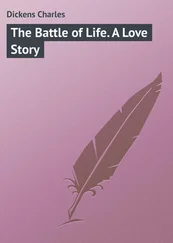Alan was 21 years old at the time. I had been the same age when I discovered Romanesque art. Both of us were in dire need of a good hard slap from the backhand of maturity. And both of us got it, though I dare say mine stung a good deal less.
Shortly after I graduated from university, on the heels of my twenty-second birthday, I moved to Washington, DC to work at the Smithsonian Institution. Washington was then, and still is, overrun by ambitious young people who intern by day and party by night. My friends grazed on free appetizers put out as bait at slick bars and danced in clubs. Sometimes I did, too, but more often I stayed home drinking cheap wine and listening to the radio while I slowly, painstakingly filled a pencil drawing I’d made with tiny black dots of Indian ink.
My drawing was copied from a photograph of the tympanum of Ste Madeline of Vézelay, a twelfth-century Romanesque abbey in Burgundy. The picture tightly focused on a man and woman who held hands as he bowed to her. They were rapturously elegant, with rows of neatly braided hair and garments blown by unseen air currents into cascades of folds. Each partner bore the snout of a pig.
These were the ‘Pig-Snouted Ethiopians’, members of the heathen damned carved onto the great abbey of Vézelay at a time when tympana mapped a geography of Christianity’s fertile imagination. Night by night, my face inches from the paper and the desk lamp inches from my head – so close I could smell my scalp cooking – I lovingly translated their big hands and heads, their slim, pointy feet and voluminous drapery from photographed stone into ink. I was in love with Romanesque sculpture.
I’d discovered this strange art, the eccentric, embarrassing forebear of Gothic sophistication, just months earlier during my final semester at Brown University, in Providence, Rhode Island. In my medieval art seminar I’d learned that the word ‘Romanesque’ had been coined in the nineteenth century with derogatory intent. It referred to the heavy, earnestly sturdy abbeys and basilicas that had begun to crop up in Europe around the turn of the first millennium, in the muddy, nameless years between the classicism of Rome and the spun stone of Gothic cathedrals.
These buildings of the eleventh and twelfth centuries had ‘Romanesque’ features – columns, capitals, arcades – but their decoration was radically unclassical. Hand in hand with the renaissance in architecture, the remembered skills of sculptors and masons had rushed back into currency as well. But instead of sculpting well-proportioned narratives of gods, these artisans freely – sometimes giddily – cut, scored, drilled, and chiselled the façades and column capitals of Europe’s Romanesque stonescape with stories from the Bible and detritus from their nightmares.
Out of the willing stone emerged hares in Hell, roasting poachers on a spit; rams playing harps and devils eating men’s brains; a female centaur pulling a mermaid’s hair; women suckling snakes at their breasts; tiny Peeping Toms. There were acrobats displaying their private parts; a man yanking out his own tooth; two warriors sharing a single penis; and in the Pyrenees, a marble dog stretching out his tongue, eternally unable to touch his water dish carved just out of reach.
Relatively little Western art before or after, excepting that of Hieronymus Bosch and the Surrealists, has been so feverishly inventive. From the beginning it was this very strangeness that was wondrous to me, this stony certitude that there was more to the world than sunlight illuminated for our eyes. Don’t misunderstand: I wasn’t looking for fairies and angels, rather confirmation that at one point in time, at least, images of the mind’s eye bore equal value to those fixed on the retina. Romanesque art stirred in me a deep, visceral joy, an inchoate thrill of imaginative validation, all the more extraordinary for spanning so many centuries.
Perhaps its appeal also betrayed the innate curiosity of a born traveller who had not yet travelled. In one of his brilliant essays on the Romanesque, Meyer Schapiro cited St Bernard’s furious twelfth-century letter condemning the then-new decoration of Clunaic abbeys. ‘What profit is there’, thundered the saint, ‘in those ridiculous monsters, in that marvellous and deformed beauty, in that beautiful deformity?’ Schapiro pointed out that Bernard sensed in those monsters an attitude that would eventually compete with Christian doctrine – ‘an attitude of spontaneous enjoyment and curiosity about the world’. A traveller’s attitude.
At the time I didn’t question too vigorously what fuelled my schoolgirl crush on the Romanesque. I just admired its easygoing, latent democracy. It was the first art of the Western tradition to place scenes of daily life – a peasant drying his socks by the fire – side by side with those of didactic importance, such as Abraham sacrificing Isaac. I felt an instinctive sympathy for its carved figures with oversized heads and eyes. Their bodies performed stunts possible only in a world unacquainted with linear perspective. Boats sailed on top of the sea, and Jesus and the Apostles evidently consumed the Last Supper in a room without gravity, where the tabletop floated before them and nothing fell off. Shoulders faced forward and knees turned to the side. After the Renaissance elevated the human eye and the illusions that please it above the soul and the cautionary tales that might save it, Romanesque art looked ridiculous. It became vulnerable; how could its ideas be taken seriously if it looked so naive?
It should come as no surprise that I did not choose the Romanesque as my field of study. I didn’t want my personal attachments supplanted by extraneous knowledge. So I left it at that, and did something else for twenty years. Then I attended the end of the world.
‘Before and After the End of Time: Architecture and the Year 1000’, read my friend Marguerite from the arts page of the newspaper, repeating the name of an exhibition so I could make a note of it. She thought it was something I might enjoy.
The show had been mounted in the second half of 2000 at the Fogg Art Museum at Harvard to commemorate the more-or-less millennial birthday of Romanesque architecture. While a copy of the Pig-Snouted Ethiopians drawing hangs in my stairwell – regrettably, I sold the original for pub money when I was a poor postgraduate at the University of Wales – I have tended not to think much about things Romanesque over the years, but I made a point of seeing the exhibition. ‘The idea of the millennium enables us to contrast what might have happened in the year 1000 – the descent of the Heavenly Jerusalem – with what did happen, the Romanesque revival of architecture,’ wrote Christine Smith, an art history professor at Harvard who curated the show. ‘We juxtapose the City of God with the City of Man, the eternal with the temporal, and the divine with the human architect.’
To give viewers something to look at as she pursued these heady divisions, Smith pulled a couple of nearly hundred-year-old black-and-white photographs from Harvard’s Fine Arts Archive. ‘Old pictures of older buildings, what could be duller?’ asked my friend Dick, who’d worked at Harvard at the time. I thought much could be duller. The black-and-white prints revealed a reverence for the tactile surface of stone. Every crack, every crumbling rough edge or rash of lichen was fixed with absolute clarity and modulation of light. These were not simple documentary photographs. They were scrupulously unsentimental, but they betrayed a sense of humour and a devotion to texture; a clear-eyed acknowledgement of great age; a sense of grace; susceptibility to valuing the overlooked. Whatever the source, there was passion in these pictures.
I checked a label for the photographer’s name: Arthur Kingsley Porter. Months passed before I discovered that his wife Lucy, or ‘Queensley’, as she was called, had actually taken most of the pictures in the show. By then I was planning my own tour around southwest France to see what she and Kingsley had seen almost a hundred years earlier, and to find out why her photographs quickened my heart. I had no idea then that their Romanesque love story would lead me to Ireland as well.
Читать дальше
